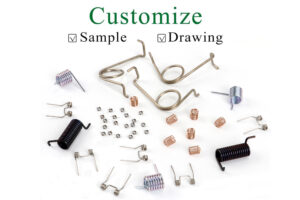The Torsion Spring Mechanism: Unleashing the Potential in Various Industries

Torsion springs are a fundamental component of mechanical systems used widely in industries such as automotive, aerospace, construction, and more. These springs store and release rotational energy, enabling a variety of applications that require torque or rotational force. This article explores the significance of torsion spring mechanisms, their design principles, and their diverse applications.
Design Principles:
Torsion springs are typically made of sturdy materials like steel or alloy, specifically selected for their high durability and resistance to fatigue. The design involves helical coils that exert a rotational force when twisted, with the amount of torque generated proportional to the spring’s dimensions and material properties. Proper design considerations, such as wire diameter, coil pitch, and number of coils, ensure optimal performance and longevity.
Applications in Various Industries:
1. Automotive Industry:
Torsion springs play a pivotal role in various automotive components. For instance, they are widely used in suspension systems, where they provide stability and balance by absorbing shocks and vibrations. Torsion bars in trucks and SUVs help maintain a level ride by resisting the twisting motion caused by uneven road surfaces. Additionally, they are used in seatbelt retractors, hinge mechanisms, and fuel door hinges, ensuring smooth operation and safety.
2. Aerospace Industry:
In the aerospace sector, where weight and space are critical considerations, torsion springs find many applications. They are used in aircraft control systems, including ailerons, elevators, and rudders, imparting the necessary torque for precise and responsive maneuvering. Torsion springs are also employed in landing gear mechanisms to absorb the impact during landing and provide stability on the ground.
3. Industrial Machinery and Equipment:
Torsion springs are widely employed in various industrial machines and equipment. They are used in garage doors and gates, enabling smooth opening and closing actions. In machinery such as clockwork mechanisms and electric motors, The springs provide the necessary torque to drive and control their rotational motion. Furthermore, torsion springs find utility in tools like wrenches and clamps, allowing for controlled gripping and torque application.
4. Construction and Architecture:
Torsion springs play a vital role in the construction and architectural industries. They are used in overhead doors and roll-up shutters, providing controlled movement and facilitating easy opening and closing. Torsion springs are also found in awnings, ensuring proper tension and preventing sagging. In addition, they are utilized in various sliding and swinging doors, ensuring smooth and effortless operation.
5. Medical Devices:
The medical field relies on torsion springs for several essential applications. They are used in surgical instruments, such as forceps and tweezers, enabling precise control and manipulation. Torsion springs also find use in prosthetic limbs, where they provide the necessary rotational force for movement and dexterity.
Conclusion:
The torsion spring mechanism is a versatile and indispensable component in many industries, facilitating the controlled release and absorption of rotational energy. Its applications range from automotive and aerospace to medical devices and construction. By understanding its design principles and implementing appropriate techniques, engineers and designers can harness the potential of torsion springs to enhance functionality, efficiency, and safety in countless applications.






